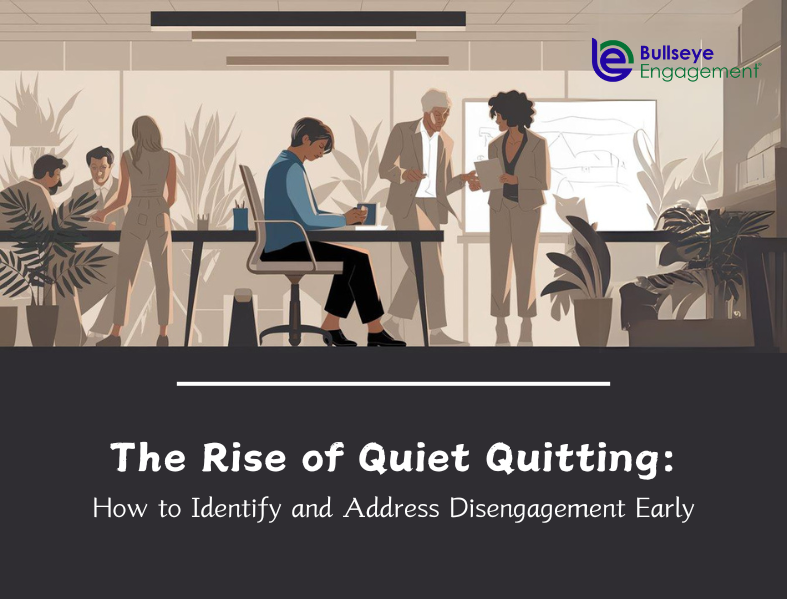In recent times, the term “quiet quitting” has taken the professional world by storm. It’s not about employees physically leaving their jobs; instead, it’s a trend where employees mentally check out—doing the bare minimum required to keep their roles but disengaging from the overall purpose and culture of the organization. While they’re still present in the office (or virtually), their enthusiasm and commitment are long gone.
Quiet quitting is often a response to burnout, lack of motivation, or feeling undervalued, and it can significantly impact a company’s culture, productivity, and bottom line. In this blog, we’ll explore the rise of quiet quitting, how to spot the early signs of disengagement, and practical strategies for addressing it before it becomes a widespread issue.
What Is Quiet Quitting?
Quiet quitting refers to employees intentionally stepping back from extra responsibilities, withdrawing from team dynamics, and limiting their effort to only what is explicitly required by their job description. While this doesn’t mean they are neglecting their duties, they are no longer proactively contributing to the company’s growth or engaging in its culture.
Unlike traditional forms of resignation, quiet quitting is subtle and often goes unnoticed until it starts affecting overall team morale and productivity. It’s essential for organizations to recognize and address this trend early to prevent it from spreading.
Why Quiet Quitting Is on the Rise
Several factors contribute to the rise of quiet quitting:
- Burnout and Stress
With the increasing demands of hybrid work, long hours, and the pressure to be constantly available, many employees face burnout. When they don’t receive adequate support or recognition, they may resort to quiet quitting as a means of self-preservation. - Lack of Growth Opportunities
Employees who feel stuck in their roles or don’t see a clear path for growth and development are more likely to disengage. If they perceive that their efforts don’t translate into meaningful career progression, they may retreat to doing the minimum required. - Absence of Recognition
When employees don’t feel appreciated for their contributions, they can lose motivation. Over time, the lack of acknowledgment can lead them to quietly disengage, as they don’t see the value in going above and beyond. - Disconnection from Company Culture
The rise of remote and hybrid work models has created a disconnect between employees and company culture. Without meaningful opportunities to connect with their peers and leaders, some employees may feel isolated and detached from the organization’s mission.
How to Identify Quiet Quitting Early
Spotting quiet quitting early is crucial to maintaining a healthy and productive work environment. Here are some signs to watch for:
- Decreased Participation
Employees who were once active in meetings or team discussions but now remain quiet or disengaged may be showing signs of quiet quitting. Look for changes in behavior, such as reduced input or reluctance to collaborate on projects. - Decline in Productivity or Quality of Work
When an employee’s work performance begins to decline, and they show little interest in improving or taking on new challenges, it could be an indication of quiet quitting. Consistent underperformance or missing deadlines can also be red flags. - Withdrawal from Social or Team Activities
Employees who withdraw from team events, social gatherings, or virtual hangouts may be struggling with engagement. If they no longer participate in activities that build connections within the team, it may be a sign that they feel disconnected or unmotivated. - Resistance to Feedback or Professional Development
Quiet quitters often show reluctance towards taking on new responsibilities or engaging in professional development opportunities. If they are no longer interested in feedback or growth conversations, it may indicate a loss of motivation.
How to Address Quiet Quitting: Proactive Strategies
Addressing quiet quitting requires a thoughtful and proactive approach. Here are some strategies to help re-engage employees and create an environment where they feel valued and motivated:
1. Foster Open Communication
Encourage a culture where employees feel comfortable expressing their concerns without fear of judgment or retaliation. Leaders should regularly check in with their teams, offering one-on-one sessions to discuss workload, challenges, and overall well-being. When employees feel heard, they are more likely to stay engaged.
Action Tip: Conduct regular pulse surveys to gather anonymous feedback on employee sentiments and engagement levels. Use this data to identify and address specific areas of concern.
2. Recognize and Reward Efforts
Recognition is a powerful motivator. When employees feel appreciated for their hard work, they are more likely to stay committed and engaged. Ensure that recognition is personalized and specific, acknowledging the individual’s unique contributions rather than generic praise.
Action Tip: Implement a peer recognition program where employees can recognize each other’s efforts. This helps create a culture of appreciation and promotes a sense of belonging.
3. Promote Work-Life Balance
Burnout is a leading cause of quiet quitting, so it’s essential to support employees in achieving a healthy work-life balance. Encourage the use of flexible work schedules, mental health days, and wellness programs that help employees recharge.
Action Tip: Offer resources such as mindfulness workshops, fitness classes, or counseling services to support employee well-being.
4. Provide Clear Growth Opportunities
Employees who see a path for career growth are more likely to remain engaged. Ensure that there are clear opportunities for learning and development, and communicate these paths effectively. Invest in upskilling programs, mentorship opportunities, and workshops that help employees advance in their careers.
Action Tip: Create individualized development plans for each team member, focusing on their strengths and career aspirations. Regularly review progress and adjust plans as needed.
5. Strengthen Team Connections
Remote and hybrid work models can make it difficult for employees to feel connected to their teams. To counter this, create opportunities for team bonding, both virtually and in-person. Activities such as virtual coffee chats, team-building exercises, or small group projects can help rebuild camaraderie.
Action Tip: Organize quarterly virtual or in-person team retreats focused on collaboration, team goals, and building connections among employees.
The Role of Leadership in Preventing Quiet Quitting
Leaders play a crucial role in preventing quiet quitting. By being proactive, empathetic, and accessible, leaders can create a supportive environment where employees feel valued and motivated to contribute their best. Here’s how leadership can make a difference:
- Lead by Example: Demonstrate a commitment to work-life balance and open communication. When leaders model these behaviors, employees are more likely to feel comfortable following suit.
- Be Transparent: Share the company’s vision, challenges, and goals with employees. Transparency builds trust and gives employees a sense of ownership in the organization’s success.
- Provide Supportive Feedback: Constructive feedback should be aimed at development rather than criticism. When employees feel supported in their growth journey, they are more likely to stay engaged.
Conclusion: Address Quiet Quitting Before It Becomes a Trend
Quiet quitting is a growing phenomenon that, if left unchecked, can impact company culture and productivity. By identifying early signs of disengagement and implementing strategies to re-engage employees, organizations can create an environment where employees feel valued, motivated, and connected.
BullseyeEngagement provides the tools you need to proactively address and prevent quiet quitting. From pulse surveys that capture real-time feedback to analytics that track engagement trends, our platform equips leaders with the insights needed to build a thriving, engaged workforce.
Ready to turn quiet quitting into enthusiastic re-engagement? Contact BullseyeEngagement today to learn how we can help you create a culture where every voice matters.
To book a Demo click here.

















